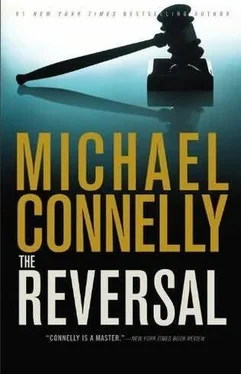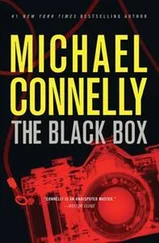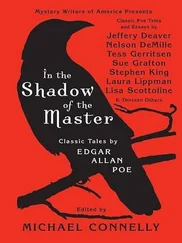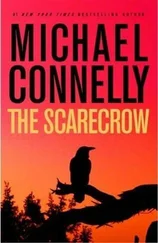Bosch turned to the board and looked at the photos of eight smiling girls. All of them long gone over time.
“I’m not saying that Jessup had anything to do with any of these girls dropping off the face of the earth, but he could have. As Maggie already noticed, they all have a resemblance to one another and to Melissa Landy. And by the way, the resemblance extends to body type as well. They’re all within ten pounds and two inches of one another and our victim.”
Bosch turned back to his audience and saw McPherson and Haller transfixed by the photographs.
“Beneath each photo I’ve put the particulars,” he said. “Physical descriptors, date and location of disappearance, the basic stuff.”
“Did Jessup know any of them?” Haller asked. “Is he connected in any way to any of them?”
That was the bottom line, Bosch knew.
“Nothing really solid-I mean, not that I’ve found so far,” he said. “The best connection that we have is this girl.”
He turned and pointed to the first photo on the left.
“The first girl. Valerie Schlicter. She disappeared in nineteen eighty-one from the same neighborhood in Riverside that Jessup grew up in. He would’ve been nineteen and she was seventeen. They both went to Riverside High but because he dropped out early, it doesn’t look like they were there at the same time. Anyway, she was counted as a runaway because there were problems in her home. It was a single-parent home. She lived with her mother and a brother and then one day about a month after graduating from high school, she split. The investigation never rose above a missing persons case, largely because of her age. She turned eighteen a month after she disappeared. In fact, I wouldn’t even call it an investigation. They more or less waited to see if she’d come home. She didn’t.”
“Nothing else?”
Bosch turned back and looked at Haller.
“So far that’s it.”
“Then discovery is not an issue. There’s nothing here. There’s no connection between Jessup and any of these girls. The closest one you have is this Riverside girl and she was five years older than Melissa Landy. This whole thing seems like a stretch.”
Bosch thought he detected a note of relief in Haller’s voice.
“Well,” he said, “there’s still another part to all of this.”
He stepped over to the case boxes at the end of the table and picked up a file. He walked it down and put it in front of McPherson.
“As you know, we’ve had Jessup under surveillance since he was released.”
McPherson opened the file and saw the stack of 8 × 10 surveillance shots of Jessup.
“With Jessup they’ve learned that there is no routine schedule, so they stick with him twenty-four/seven. And what they’re documenting is that he has two remarkably different lives. The public one, which is carried in the media as his so-called journey to freedom. Everything from smiling for the cameras and eating hamburgers to surfing Venice Beach to the talk-show circuit.”
“Yes, we’re well aware,” Haller said. “And most of it orchestrated by his attorney.”
“And then there’s the private side,” Bosch said. “The bar crawls, the late-night cruising and the middle-of-the-night visits.”
“Visits where?” McPherson asked.
Bosch went to his last visual aid, a map of the Santa Monica Mountains. He unfolded it on the table in front of them.
“Nine different times since his release Jessup has left the apartment where he stays in Venice and in the middle of the night driven up to Mulholland on top of the mountains. From there he has visited one or two of the canyon parks up there per night. Franklin Canyon is his favorite. He’s been there six times. But he also has hit Stone Canyon, Runyon Canyon and the overlook at Fryman Canyon a few times each.”
“What’s he doing at these places?” McPherson asked.
“Well, first of all, these are public parks that are closed at dusk,” Bosch replied. “So he’s sneaking in. We’re talking two, three o’clock in the morning. He goes in and he just sort of sits. He communes. He lit candles a couple times. Always the same spots in each of the parks. Usually on a trail or by a tree. We don’t have photos because it’s too dark and we can’t risk getting in close. I’ve gone out with the SIS a couple times this week and watched. It looks like he just sort of meditates.”
Bosch circled the four parks on the map. Each was off Mulholland and close to the others.
“Have you talked to your profiler about all this?” Haller asked.
“Yeah, I did, and she was thinking what I was thinking. That he’s visiting graves. Communing with the dead… his victims.”
“Oh, man…,” Haller said.
“Yeah,” Bosch said.
There was a long pause as Haller and McPherson considered the implications of Bosch’s investigation.
“Harry, has anybody done any digging in any of these spots?” McPherson asked.
“No, not yet. We didn’t want to go too crazy with the shovels, because he keeps coming back. He’d know something was up and we don’t want that yet.”
“Right. What about-”
“Cadaver dogs. Yeah, we brought them out there undercover yesterday. We-”
“How do you make a dog go undercover?” Haller asked.
Bosch started to laugh and it eased some of the tension in the room.
“What I mean is, there were two dogs and they weren’t brought out in official vehicles and handled by people in uniforms. We tried to make it look like somebody walking their dog, but even that was a problem because the park doesn’t allow dogs on these trails. Anyway, we did the best we could and got in and got out. I checked with SIS to make sure Jessup wasn’t anywhere near Mulholland when we went in. He was surfing.”
“And?” McPherson asked impatiently.
“These dogs are the type that just lie down on the ground when they pick up the scent of human decay. Supposedly they can pick it up through the ground after even a hundred years. Anyway, at three of the four places Jessup’s gone in these parks, the dogs didn’t react. But at one spot one of the two dogs did.”
Bosch watched McPherson swivel in her seat and look at Haller. He looked back at her and there was some sort of silent communication there.
“It should also be noted that this particular dog has a history of being wrong-that is, giving a false positive-about a third of the time,” Bosch said. “The other dog didn’t react to the same spot.”
“Great,” Haller said. “So what does that tell us?”
“Well, that’s why I invited you over,” Bosch said. “We’ve reached the point where maybe we should start digging. At least in that one spot. But if we do, we run the risk that Jessup will find out and he’ll know we’ve been following him. And if we dig and we find human remains, do we have enough here to charge Jessup?”
McPherson leaned forward while Haller leaned back, clearly deferring to his second chair.
“Well, I see no legal embargo on digging,” she finally said. “It’s public property and there is nothing that would stop you legally. No need for a search warrant. But do you want to dig right now based on this one dog with what seems like a high false-positive rate, or do we wait until after the trial?”
“Or maybe even during the trial,” Haller said.
“The second question is the more difficult,” McPherson said. “For the sake of argument, let’s say there are remains buried in one or even all of those spots. Yes, Jessup’s activities seem to form an awareness of what is below the earth in the places he visits in the middle of the night. But does that prove he’s responsible? Hardly. We could charge him, yes, but he could mount a number of defenses based on what we know right now. You agree, Michael?”
Читать дальше












